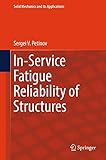In-Service Fatigue Reliability of Structures [electronic resource] / by Sergei V. Petinov.
By: Petinov, Sergei V [author.] .
.
Contributor(s): SpringerLink (Online service) .
.
Material type:  BookSeries: Solid Mechanics and Its Applications: 251Publisher: Cham : Springer International Publishing : Imprint: Springer, 2018Edition: 1st ed. 2018.Description: XVI, 201 p. 112 illus., 10 illus. in color. online resource.Content type: text Media type: computer Carrier type: online resourceISBN: 9783319893181.Subject(s): Engineering design
BookSeries: Solid Mechanics and Its Applications: 251Publisher: Cham : Springer International Publishing : Imprint: Springer, 2018Edition: 1st ed. 2018.Description: XVI, 201 p. 112 illus., 10 illus. in color. online resource.Content type: text Media type: computer Carrier type: online resourceISBN: 9783319893181.Subject(s): Engineering designIntroduction: Reliability of Technologies -- Service Life Prediction in the Design Phase -- Assessment of the Residual Life -- Elements of Theory of Probability -- Random Events and Random Variables -- Statistics of Random Variables. Probability Distributions -- Evaluation of Statistics of a Random Process -- Basics of Statistical Dynamics. Spectral Method -- Elements of Spectral Analysis of a Stationary Random Process -- Forced oscillations of a single degree of freedom dynamic system -- Wiener-Khinchin Theorem. Evaluation of the Output Process Statistics -- Service Loads -- Classification of Service Loads on Structures -- Service Loads – Continuous Successions. Spectral and Statistical Characrerization -- Spectral Characterization of Loads -- Fatigue Behavior of Materials and Structural Components -- Fatigue Characterization of Structural Materials -- Principles of Modeling Fatigue Behavior of Structures -- Current Approaches to Fatigue of Structures in Design and in Service Conditions -- Numerical Examples -- Residual Life Assessment of Structures when Fatigue Cracks are Detected -- Effect of Fatigue Cracks on the Service Life Assessment of Structures -- Modeling of Fatigue Crack Propagation in Structures -- Evaluation of Residual Life Numerical Examples -- Criteria for Critical Conditions of Structures -- Instable Fracture of Cracked Structures -- Griffith-Irvin Theory. Experimental Evaluation of Criteria for Fracture -- Alternative Approaches to Fatigue Life Assessment of Structures -- The Damage Accumulation Methodology in Conjunction with the FE-modeling -- The Prospects of Combining the Damage Accumulation and Linear Fracture Mechanics Methodologies -- Numerical Examples -- Principles of Organizing the In-Service Reliability of Structures -- Techniques of Experimental Evaluation of the Reliability Parameters -- Principles of Monitoring the In-Service Reliability of Structures.
This book provides readers with the latest know-how and tools needed to assess the in-service strength and reliability of welded structures. It addresses the two principal mechanisms of structural material deterioration, fatigue and corrosion, which affect the in-service behavior of structures. In this regard, the primary focus is on fatigue in connection with various structural failure scenarios. Realistic and typical examples of welded structures’ design and residual life assessment are used throughout the book in order to show readers the complexity of real-world assessments. The book offers a valuable resource for master’s students in mechanical and civil engineering, and for engineers whose work involves fatigue design and in-service inspections of welded structures.


There are no comments for this item.